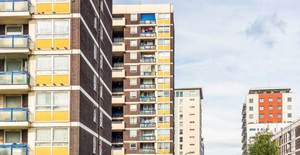Out-Law Analysis 3 min. read
Repurposing property for residential use in the wake of coronavirus
08 Feb 2021, 4:46 pm
The Covid-19 pandemic has had a profound effect on the way that real estate is used and occupied. Its impact is likely to be long-lasting and could prompt a shift in investment trends towards residential properties.
In the short term there has been disruption caused by restrictions on opening and accessing commercial property. More broadly, the pandemic has accelerated a number of trends that have been seen in the retail, office and other sectors for some time.
In retail, the flight of customers from physical stores to online shopping is well known. In offices, the trend towards increased flexible and agile working was also being seen well before Covid-19 came along, but this has now increased and is likely to continue as employers and employees alike see the benefits.
As a result, many investors in real estate will be appraising their portfolio with a view to diversifying their interests, increasing its robustness and realigning it to fit with the changed requirements of occupiers post-Covid.

Anthony Newton
Partner
While by no means the only option, it is very likely that residential use will feature in the minds of most given the shortage in residential accommodation and the resilience that this asset class has shown
For an increasing number, this will point towards repurposing assets by either bringing in complementary uses or changing its use altogether to improve its performance and value. While by no means the only option, it is very likely that residential use will feature in the minds of most given the shortage in residential accommodation and the resilience that this asset class has shown.
Following the dreadful events at Grenfell Tower in 2017, fire and building safety in residential property has rightly been high on the UK government's list of priorities. The Building Safety Bill was published in July 2020 and is currently going through the parliamentary process. The essential elements of the Bill have been well-trailed and are unlikely to change significantly.
The reforms will impose additional duties on owners, occupiers and managers of ‘higher-risk buildings’ as well as those involved in constructing them. For now, higher risk buildings are those with a height of 18 metres or more than six storeys, ignoring rooftop plant or storeys below ground level, and which contain two or more ‘dwellings’ – rooms used for residential purposes or as student accommodation.
The definition of higher-risk buildings means that mixed-use buildings with a residential element will be caught by the new rules provided they meet the height requirement, and so the Bill should not just be seen as something that applies to high-rise residential properties.
Importantly, the rules will affect not only new-build projects, but also existing high-risk buildings and those which undergo a major refurbishment – although at present detailed provisions from government on the transitional arrangements are awaited.
It is also worth bearing in mind that, in time, the government intends to reduce the height requirements further and to extend the scope of the regime to include other types of building so all owners, occupiers and managers of buildings with a residential element should be familiarising themselves with the rules in relation to their existing assets and when acquiring new stock where there is a residential element.
Failure to comply with the regime is likely to result in criminal sanctions and reputational damage as well as impacting on the ability to sell or let the building. Given this, building and fire safety should be considered from the outset in relation to any repurposing project which will include a residential element.
Where, for example, it is proposed to build over a shopping centre, to convert a number of floors of an office block or to build in the car park of a leisure scheme, if residential use is included and the height condition is met, additional duties will be imposed not just on the residential element, but potentially on the wider building or even, in some cases, the wider estate.
As well as the additional costs of compliance, including developing a building ‘safety case’ and registering the building with the regulator – effectively the Health and Safety Executive – the new regime is likely to lengthen the timescales required for the planning and building control process and may require additional works to the wider building or estate. This will need to be factored into the programme and appraisal for the project.
None of this is insurmountable, provided that building and fire safety is considered and, as necessary, incorporated at an early stage as part of any repurposing project.
Latest News
Editor's Pick
Out-Law News
26 Nov 2020


